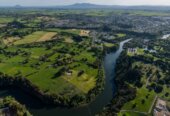The daily guano – droppings – of an estimated half million birds has started to affect the water quality of a Waipā peat lake.
It’s labelled an “unintended consequence” of predator control.

Photo: Benjamin Wilson
Conservation efforts made by the National Wetland Trust (NWT) have kept Rotopiko’s East Lake free of mammalian predators since 2014.
The News has previously reported that due to its lack of predators, the lake, which is surrounded by a 1.4km predator exclusion fence, has unintentionally become a sanctuary for introduced species of bird, mostly starlings and sparrows.
Now the impact on the lake is becoming more evident.
“What has happened is, after we built the predator proof fence and got rid of all of the pests, the starlings and sparrows now think it is the best place to roost because there are no rats. They all feed out in the farmlands and blueberries fields, and then come back to Rotopiko to roost together,” said NWT executive officer, Karen Denyer.
Using research obtained by Toi Ohomai and Wintec science students, the trust estimated last year that 500,000 birds roost around the peat lake complex each night.

The National Wetland Trust estimate that 500,000 birds roost at Rotopiko every night.
The trust has tried different techniques of deterring the birds including the use sound, light and smell deterrents.
Denyer said they have had limited success in getting rid of the birds and now the focus is on the lake, which is starting to show signs of nutrient enrichment, caused by the large amount of guano being produced by the birds.
“They release huge amounts of guano every night and all of that dung ends up in the waterways. That is our concern, that it could contaminate the peat lakes, which are naturally meant to be low in nutrients,” she said.
“It hasn’t happened, but it could happen, and it is starting to show signs of nutrient enrichment.”

The guano produced by the birds has caused the lake to show signs of nutrient enrichment.
Denyer said the trust are still trying to find ways to get rid of the birds, but they primarily need to think about the water’s nutrient levels, so they are trailing options like dropping trees which overhang drains, or plantings that can help to denitrify the water.
A hui next week comprising of local government staff and scientists will discuss ways of preventing further nutrient enrichment of the Rotopiko lakes.
“Waikato Regional Council and DOC are funding a number of scientists to come together to try and help us with this with some new thinking,” said Denyer.
The trust initially hoped their predator control efforts would encourage native birds to thrive at Rotopiko.
“It is one of those unintended consequences, we are trying to go predator free New Zealand, but what happens to the exotic birds? Are we thinking enough about that?”









